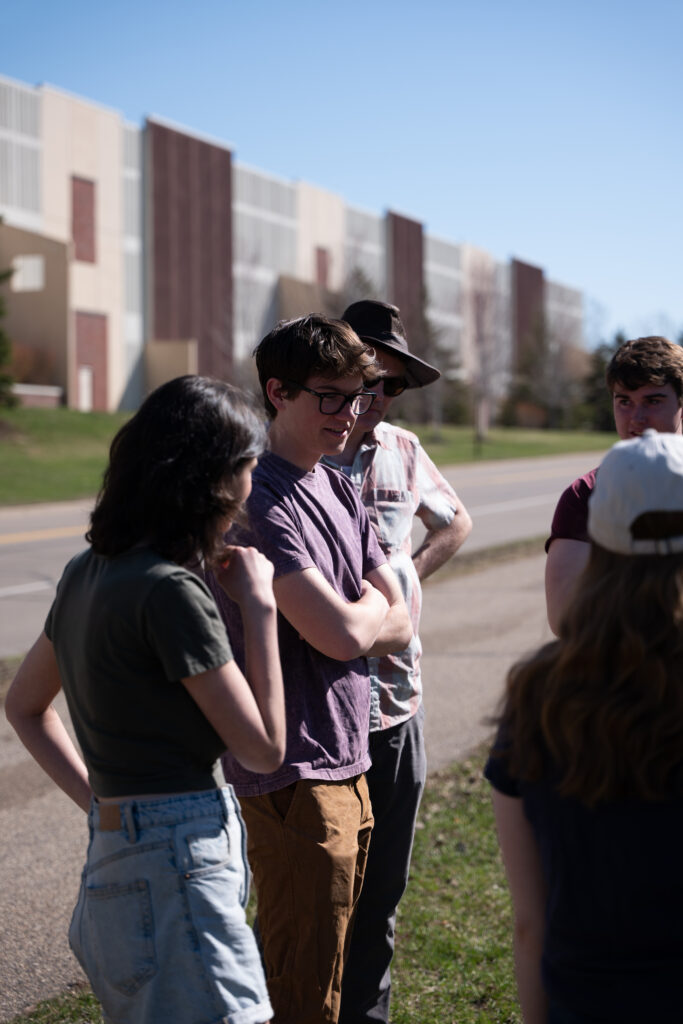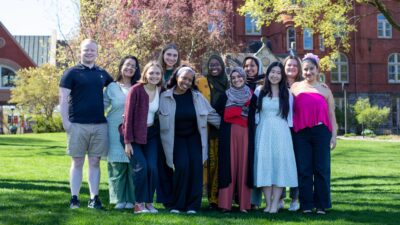
A Geographical Perspective of Pre-welfare America
By Talia Bank ’23 | Photos by John Schoolmeesters
“It’s always a good question to ask, ‘What has happened on this land?’ And that gets you into thinking about institutions, identities, communities, and the kinds of relationships that have been possible in a certain place.”
—Professor McClelland
Throughout the nineteenth and early twentieth centuries, before the federal government launched its New Deal welfare programs, people in need often relied on support at the local county level. In many cases, they lived and worked on “poor farms,” county-run residences designed to be self-sustaining by growing their own food. Over sixty counties in Minnesota alone had poor farms, and there may have been as many as two thousand nationwide, each uniquely situated within systems of local governance. And yet, these ubiquitous institutions are relatively absent from mainstream American history.
In his geography course, Unearthing the Poor Farm: Local Geographies of Land, Law and Livelihood, Professor Jesse McClelland seeks to explore the untold stories of these forgotten places. Before turning his academic focus to poor farms, McClelland learned of personal ties to these historical institutions. He grew up attending the Minnesota State Fair, the former site of the Ramsey County poor farm, and later discovered that his great-grandfather had lived on a poor farm in Missouri.
“I grew up in the Como neighborhood of St. Paul, so that was a part of the city I was fascinated in. It’s always a good question to ask, ‘What has happened on this land?’ And that gets you into thinking about institutions, identities, communities, and the kinds of relationships that have been possible in a certain place,” McClelland says. “What I’m trying to do with students is develop a collaborative research process that advances a public-facing geography.”
To gain a holistic understanding of the role, function, and operations of poor farms in American society, students dig into archival material and explore various aspects of poor farms, including their geography, their public perceptions, who lived and worked there, and what kinds of relationships residents had with their environment and one another. By studying poor farms as more than just local welfare institutions, their complex implications for history and sociology come to light.
 “In the north of the U.S., some residents of poor farms were locally born white people, some were migrants from Europe, and a few were Black, including some formerly enslaved people. Many who came to these frontier areas had disabled bodies or were elderly, and were not found to have any value in the labor market,” McClelland says. “We get this very complicated sketch of people who were vulnerable as a sort of surplus in the local economy. And where do they go? What’s the obligation of the community? You start to see there’s a procedure, a form of managing these people’s lives. And so, it’s sticky. When I talk to my students about this, I try to keep these possible directions and contradictions alive.”
“In the north of the U.S., some residents of poor farms were locally born white people, some were migrants from Europe, and a few were Black, including some formerly enslaved people. Many who came to these frontier areas had disabled bodies or were elderly, and were not found to have any value in the labor market,” McClelland says. “We get this very complicated sketch of people who were vulnerable as a sort of surplus in the local economy. And where do they go? What’s the obligation of the community? You start to see there’s a procedure, a form of managing these people’s lives. And so, it’s sticky. When I talk to my students about this, I try to keep these possible directions and contradictions alive.”
Poor farms therefore served as places to work, rest, and be for those who had nowhere else to turn. At the same time, they subjected people to a regulated way of life without necessarily providing them with the skills, training, or support that would allow them to live independently. For McClelland’s class, understanding the poor farm as a space that allowed for both of these truths opens up broader conversations around how welfare did and should function.
Given the interdisciplinary nature of this topic, students bring various perspectives to the course and hone in on different aspects of the history. Maura Haas ’23 (Chicago) had not done much historical research prior to taking the class. But as a geography major, she approached the archives with an eye toward physically mapping the built environment. As part of the course’s final project, Haas aims to map the Hennepin County Poor Farm by combing through archival material like newspapers to figure out what daily life looked like on the grounds.
Matthew Trager ’23 (Mazomanie, Wis.), a philosophy major, chose to take the class precisely because of its interdisciplinary approach and focus on social science. He aims to bridge his interest in philosophy to the historical debates for and against poor farms as precursors to modern-day welfare.
“I have learned a lot about how to be a social scientist,” Trager says. “The poor farm is also a progenitor to a bunch of modern institutions like elderly care or mental health care, so it’s also interesting to think about the poor farm as this transitional institution.”
In this way, looking back at poor farms not only highlights a relatively unknown facet of American history, but also serves to contextualize present-day welfare systems and trace throughlines between geography, sociology, and history.
“I think there’s a lot of hesitancy because people see it as a scar in landscape, a scar in history. This type of institution sometimes warrants almost a fear of it,” Haas says. “It’s a lot of things, it’s in-between. It’s like a little puzzle of its own. It feels like every little thing I find is some groundbreaking discovery.”
April 26 2023
Back to top




